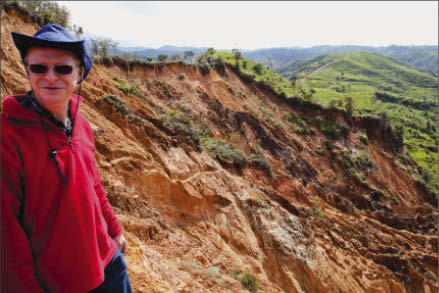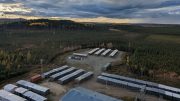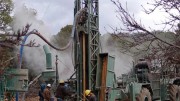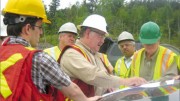In recent years as drugs and violence fade from the headlines, Colombia has seen a deluge of juniors pouring in and looking to take part in the gold-rich country’s seemingly endless untapped potential.
But that popularity is starting to take its toll, and those juniors not among the 40 or so already in the country will find it a crowded place. The government has been so overwhelmed with concession applications that in early 2011 it suspended new applications, and recently extended the suspension two more months. The country has also announced plans to take big chunks of the country that do not have pending claims and auction them off, rather than leave them open to staking.
Fortunately for Red Eagle Mining (RD-V), it made the decision to get into Colombia back in 2012, which in boom times seems like ages ago. Today the company is actively exploring its two gold prospects and a copper prospect with lots of drill results expected out this year.
Ian Slater, chairman and CEO of Red Eagle, made the jump to the country after seeing a property prospect-generator Miranda Gold (MAD-V) held yjere and deciding he wanted to make a go of it.
“I liked Pavo Real so much that I asked if we could option it,” Slater says from Red Eagle’s Vancouver office, which also serves as home to Kazakhstan-focused
Slater Mining (SLM-V) that he heads, and privately held Black Eagle Mining where he is chairman.
Since Slater also happened to be a director at Miranda, introductions weren’t necessary, but Miranda still hammered out a standard third-party agreement with then-private Red Eagle. The deal has Red Eagle earning 70% of the 51-sq.-km Pavo Real gold project if it spends US$4 million on the property over four years, and then either finishes a feasibility study or spends US$1 million a year for the next 10 years.
Later in 2010, while Red Eagle was still private, the company also came across the Santa Rosa property 70 km north of Medellin. The property can be reached largely on paved roads: first on the highway out of the city, and then up a long and winding road at 2,400 metres elevation. The Red Eagle team were drawn to the property’s history and abundant gold.
“We looked at dozens of properties, but Santa Rosa was in one of the oldest mining areas of Colombia,” Slater says. He adds that a map he found in a book from the 1950s, which listed all of the country’s major mines, helped convince him of the property’s potential.
“If you look at that old map, all the famous ones are on there,” Slater says. “Buritica, Marmato, Frontino, they’re all on that map. And so is Santa Rosa.”
The property’s history goes back much further than the 1950s, though, with King Philip IV of Spain approving the nearby town of Santa Rosa de Osos as a base for mining in the area in the 1600s. During Spanish rule the area was sluice mined extensively for gold, with over 60 areas targeted and an estimated 30 million tonnes processed.
Today the sluice sites are still visible, as is evidence of more recent mining. The rolling hills around the property, now covered by cattle fields and a few tree tomato plantations, are also dotted by 300 adits and other old mine infrastructure.
“If you just walk along the ridge lines of all those sluices, you can physically see the veins, the mineralization they were mining,” Slater says. “And you can go into the adits and see it, and go in the shafts and see it at depth. It’s clearly there.”
The local property vendors, from whom Red Eagle bought the 32-sq.-km property for US$8.2 million, are running small-scale mines on the site even today, but that is slowly being phased out. At the small mine still active on the property, where locals crush ore with hammers, Red Eagle sampled a head grade of 98 grams gold.
It’s this scale and scope of gold-mining activity that has Slater excited about Santa Rosa.
“You can pan gold anywhere on the property, and you can see how 400 years ago they mined 30 million tonnes,” Slater says. “So there was clearly potential for gold in the sulphides, as well as what they mined in the oxides.”
Santa Rosa, with numerous gold showings and no modern exploration, is a clear example of a property that would have likely already been snapped up by an explorer long ago had it not been for Colombia’s years of violence.
Of course Red Eagle didn’t come to Colombia to take over a few small-scale adits. At both its Santa Rosa and Pavo Real properties the company is looking for big gold deposits that will justify big investments.
“What we were targeting were disseminated projects, a one-gram open pit — not vein mining,” Slater says.
So far the Santa Rosa has conformed to those expectations following two rounds of drill results from an ongoing 20,000-metre program the company launched last September.
Targeting the San Ramon shear zone at depth in the southeast sector of the property, results from the first round included 40 metres grading 1.35 grams gold from 297 metres depth, 20 metres carrying 1.11 grams gold from 344 metres downhole and 20 metres at 0.85 gram gold from 237 metres.
The second round, released in mid-January, proved more encouraging. On the San Ramon shear zone hole 11 cut 60 metres grading 1 gram gold from 80 metres depth, hole 15 cut 15 metres averaging 2.51 grams gold from 179 metres depth and hole 16 intersected 54 metres at 1.01 grams gold from 56 metres depth.
“It seems to be spread over wide intervals, which is what I like,” Tim Neall, chief project geologist at Red Eagle, says during the site visit.
The mineralization at Santa Rosa is made up of quartz-carbonate veins, located in the moderate to steeply dipping shear zones.
The first 15 holes into the San Ramon shear zone have identified a mineralized horizon over 1.8 km that extends to at least 200 metres depth. While the broadest width came in at 60 metres the average was 19 metres, with all holes that targeted the shear zone hitting mineralization.
“There aren’t many initial drill programs where all 15 holes hit the shear zone,” Slater says of the results.
The company also targeted anomalies farther west it had identified through an induced polarization survey, but abandoned the model when none of the eight holes hit mineralization.
Red Eagle is now drilling on targets in the northwest area, which saw the most historic activity, and the central area, which contains a northwest-trending magnetic and radiometric anomaly. Both targets are accessible after extensive road building in late 2011. Everyone at the company talks with excitement of having the roads in place, having overcome serious difficulties while building them during the rainy season. Locals, who also use the rural roads, are apparently happy about the upgrades as well.
But with the rigs largely limited to roadside sites, the company is looking to get a man-portable rig for the project for more flexibility.
“It would take a lot more road building to get the ideal positions,” Neall notes.
And while upgrading roads proved challenging at Santa Rosa, building roads at Pavo Real is not currently an option.
Driving from the company’s secondary office just outside of Ibague to the project, Bob Bell, a director at Red Eagle, points to a steep, greenery-covered slope in the distance as our destination.
“Getting around here is not easy,” Bell notes as the pickup truck takes on a distinctly slanted angle and we start the slow, winding climb to get near the site. Once out of the vehicle the journey starts on foot: first hiking, next downhil
l along grassy and sometimes steep grazing slopes and then under a couple of barbed-wire fences before reaching the first outcrops.
Bell is quick to note that the trek is nothing compared with what the local employees face, who have to climb 500 vertical metres up the hillside to get to work each day. So far they have been using 20-man teams to move the portable rigs, but with the heaviest part weighing 600 kg and the whole thing at 5 tonnes, the company is looking into the possibility of just dragging the parts up the hillside with a winch system.
The terrain, combined with lots of ground cover, helps explain why the property has not seen much mineral-related activity, though the company removed some trespassers conducting rather small-scale mining.
Bell explains that the target was first found through stream-sediment sampling starting at the bottom of the hill that was later followed up, which has proven effective throughout wet and hilly Colombia.
The company is also employing mobile metal ion (MMI) geochemistry, both at Pavo Real and Santa Rosa, to help compensate for the sometimes thick ground cover. MMI geochemistry is a process that precisely measures the metal ions in the soil, which are theoretically there because they have migrated upwards from an orebody through the soils. Bell says it has proven quite effective and wonders why more people don’t use the technology.
Meanwhile channel sampling near some of the few artisanal adits on site returned widths such as 27 metres grading 2.23 grams gold, while surface trenching showed results up to 11 metres averaging 4 grams gold.
“There’s definitely something down there,” Bell said, noting that with only 15% of the company’s tenements in the area explored so far, “we’re going to be here for a long time.”
Red Eagle is following up on the most promising targets, with a 5,000-metre drill program started in November. The company is targeting broad quartz vein and veinlet systems in sedimentary host rocks and mineralized hydrothermal breccia zones, while the structural geology of the site looks closely related to strong radiometric potassic alteration zones.
Pavo Real again shows the incredible untapped potential of Colombia, with high-grade surface showings in an area that no one else is actively exploring. But at the same time, the property shows the already-crowded claim situation in the country, with
AngloGold Ashanti (AU-N) boxing the company in on multiple fronts. The South African giant even has an 80-metre-wide swath of property that cuts straight through Red Eagle’s property — useless for Anglo, but certainly a nuisance for Red Eagle.
Red Eagle is trying to arrange a land swap so it can consolidate its land position, but regional manager turnover at Anglo, and no incentive for haste, means no deal has yet been reached.
Claim issues could also be a nuisance for the company at its Santa Rosa project in the future, for while it has a significant amount of land in the area, there are a few gaps. The company contracted a local expert to figure out the claims situation — the official land database is fairly flawed — and found it could add to its position by applying for the claims. But with new claims suspended it is still waiting to apply.
Only a little more than six months into its exploration program, the company has lots of targets to choose from. The company only really got started after its initial public offering in June 2011. And, thanks to healthy private and public financings at 75¢ and $1.25, the company came out of the gate with $25 million in the bank. As of early February it had US$8.5 million left, and 35.9 million shares outstanding.
In those six months the company has launched drill programs on its two most promising projects, and plans to start drilling Mina Vieja, its high-grade copper prospect near Ibague, later this year. The company can also boast of having valuable local infrastructure, with its Medellin and Ibague offices, field operations and vehicles and no less than 15 geologists in the country.
The company has also assembled a strong management team, including: Slater as a former CEO in the Lundin Group and former head of Ernst & Young’s mining practice; Bell, who has over 40 years in the industry, including several stints as a mine manager and founding partner of Minproc Engineers’ mining division; Robert Pease, another director, who was previously CEO of Terrane Metals and a senior manager at Placer Dome; and Ken Cunningham, also a director, and the current CEO of Miranda Gold.
Despite the progress, and perhaps owing to the sometimes inflated expectations that now come with Colombia, the company’s share price has declined from its debut at over a dollar to 75¢. But that could quickly change, especially given that people want to invest in the country. Foreign direct investment in Colombia has gone from US$2 billion in 2002 to US$15 billion in 2011, and an expected US$16 billion this year. With most investments going to energy and mining, the country will surely see continued impressive discoveries, but also experience increased competition and bottlenecks.
The investments point to Colombia’s potential, but government moves, combined with all the land the 40 juniors and a few majors have already snapped up, must make any explorer not already in the country a little wary of their prospects.
Red Eagle has already carved out several interesting pieces of real estate that should sustain it for some time to come, and a solid base from which to grow.





Be the first to comment on "Red Eagle spreads its wings"